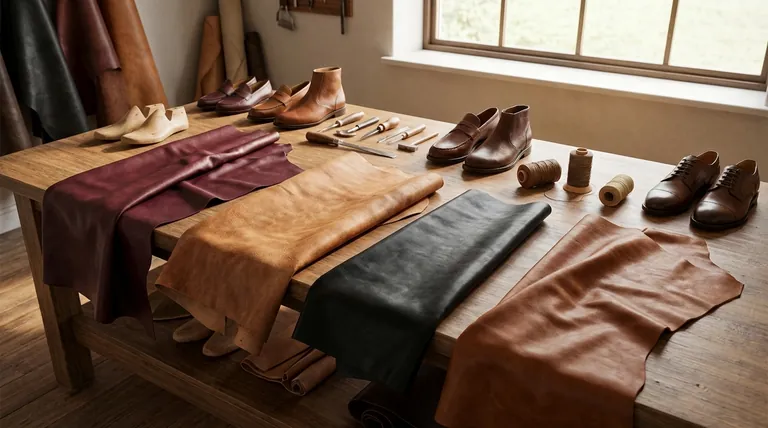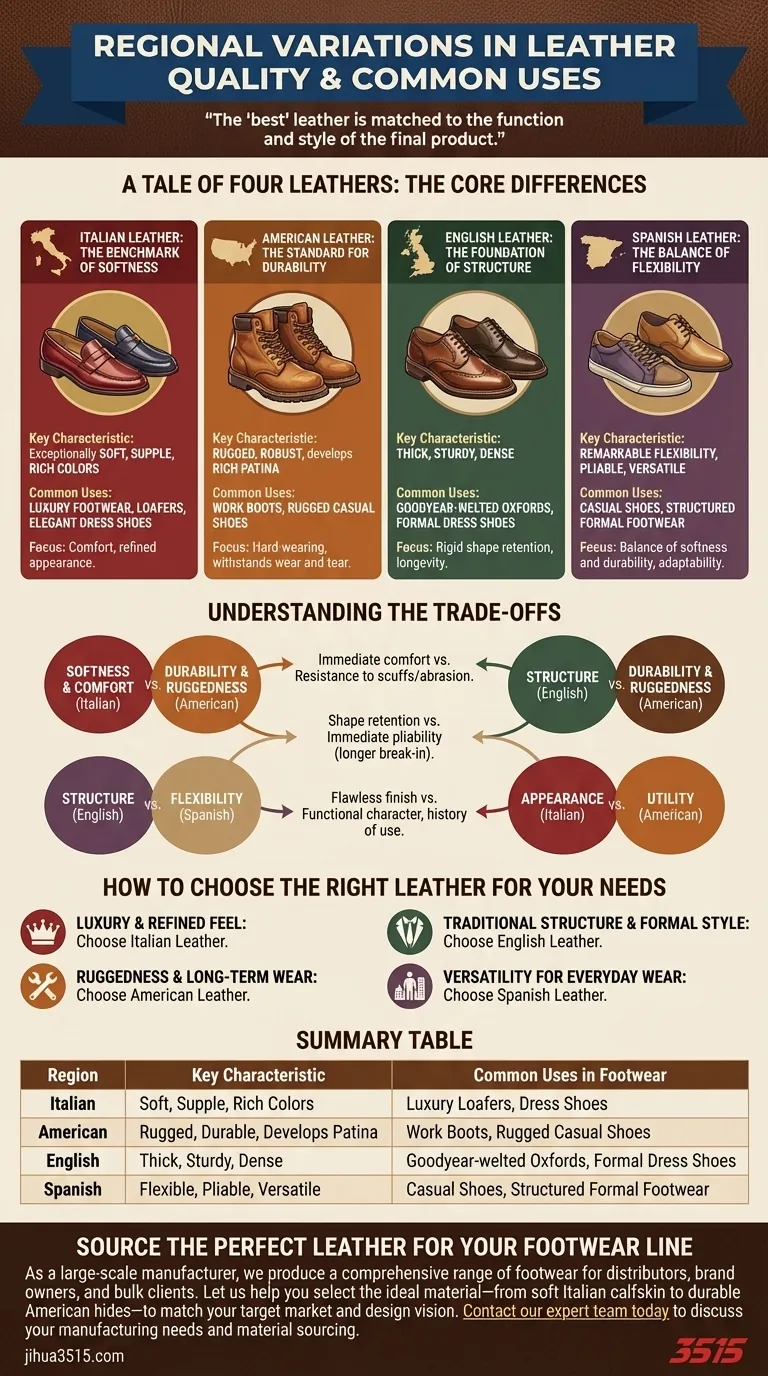In the world of fine goods, a leather’s origin tells a story about its character and intended use. Italian leather is prized for its soft, supple feel and rich colors, making it ideal for luxury footwear. In contrast, American leather is known for its rugged durability, English leather for its thick structure, and Spanish leather for its versatile flexibility.
The "best" leather is not determined by a single country of origin, but by how well its unique properties—like Italian softness or American toughness—are matched to the function and style of the final product.

A Tale of Four Leathers: The Core Differences
The environment, tanning traditions, and the type of cattle all contribute to the distinct characteristics of leather from different regions. Understanding these profiles is key to appreciating why a specific leather is chosen for a specific shoe.
Italian Leather: The Benchmark of Softness
Italian tanneries are masters of creating leather that is exceptionally soft and supple. This focus on a luxurious feel, combined with vibrant and deep coloring, makes it the global standard for high-end fashion.
Its primary use is in luxury footwear, like loafers and elegant dress shoes, where comfort and a refined appearance are the most critical factors.
American Leather: The Standard for Durability
American leather, often from brands like Horween, is synonymous with robustness and strength. It is engineered to be hard-wearing and to develop a rich patina over a long life of heavy use.
This makes it the perfect material for work boots and rugged casual shoes that must withstand significant wear and tear while providing reliable support.
English Leather: The Foundation of Structure
English leather is characteristically thick, sturdy, and dense. This gives it a unique structural integrity that is highly valued in traditional shoemaking.
It is the preferred choice for classic, formal Goodyear-welted dress shoes, such as oxfords, where maintaining a rigid shape and ensuring decades of longevity is paramount.
Spanish Leather: The Balance of Flexibility
Spanish leather is known for its remarkable flexibility and pliable nature. It strikes a unique balance between softness and durability, making it highly versatile.
This adaptability allows it to be used effectively in a wide range of products, from comfortable casual shoes to more structured formal footwear.
Understanding the Trade-offs
Choosing a leather always involves balancing competing characteristics. The very quality that makes a leather ideal for one purpose can be a disadvantage for another.
Softness vs. Durability
The luxurious softness of Italian leather means it may be less resistant to scuffs and abrasion than its American counterpart. You gain immediate comfort at the expense of ruggedness.
Structure vs. Flexibility
The rigidity of English leather provides excellent support and shape retention for a formal shoe. However, it often requires a longer break-in period compared to the more immediately pliable Spanish leather.
Appearance vs. Utility
While all quality leathers are beautiful, the emphasis differs. Italian leather prioritizes a flawless, often colorful, finish for high-fashion appeal, whereas American leather prioritizes a functional, durable character that shows its history of use.
How to Choose the Right Leather for Your Needs
Selecting the right product comes down to aligning the leather’s inherent qualities with your primary goal.
- If your primary focus is luxury and a refined feel: Italian leather's unmatched softness makes it the superior choice for elegant footwear.
- If your primary focus is ruggedness and long-term wear: American leather provides the exceptional durability required for work or heavy casual use.
- If your primary focus is traditional structure and formal style: English leather offers the sturdiness and shape retention essential for classic dress shoes.
- If your primary focus is versatility for everyday wear: Spanish leather provides a comfortable blend of flexibility and style suitable for many occasions.
Ultimately, understanding the origin of the leather empowers you to choose a product based on performance and purpose, not just a label.
Summary Table:
| Region | Key Characteristic | Common Uses in Footwear |
|---|---|---|
| Italian | Soft, Supple, Rich Colors | Luxury Loafers, Dress Shoes |
| American | Rugged, Durable, Develops Patina | Work Boots, Rugged Casual Shoes |
| English | Thick, Sturdy, Dense | Goodyear-welted Oxfords, Formal Dress Shoes |
| Spanish | Flexible, Pliable, Versatile | Casual Shoes, Structured Formal Footwear |
Source the Perfect Leather for Your Footwear Line
As a large-scale manufacturer, 3515 produces a comprehensive range of footwear for distributors, brand owners, and bulk clients. Our production capabilities encompass all types of shoes and boots. We understand that the right leather is fundamental to your product's success. Let us help you select the ideal material—from soft Italian calfskin for luxury loafers to durable American hides for rugged work boots—to perfectly match your target market and design vision.
Contact our expert team today to discuss your manufacturing needs and material sourcing.
Visual Guide

Related Products
- Wholesale Comfort Leather Business Shoes with Dial Lacing System
- Durable Rubber-Soled Utility Shoes for Wholesale & Custom Brand Manufacturing
- Wholesale Women's Leather Derby Shoes Custom Factory Production
- Custom OEM Training Shoes Wholesale Manufacturer Durable & Breathable
- Durable Leather Safety Boots for Wholesale & Custom OEM Manufacturing
People Also Ask
- What are the environmental benefits of choosing real leather shoes? Durability and Waste Reduction
- What are the benefits of seamless leather in office work shoes? Eliminate Friction for All-Day Comfort
- What should consumers look for to avoid misleading claims about leather quality? A Guide to Identifying Genuine Quality
- What should be known about genuine leather for shoes? Don't Be Misled by the Label
- Are sneakers acceptable in a business casual workplace? How to Choose the Right Style



















